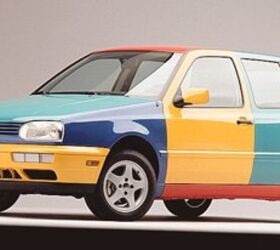The Vw Harlequin, a vibrant splash of color in the automotive landscape, remains one of Volkswagen’s most memorable and unique creations. This multi-colored marvel, a special edition of the 1996 Golf, continues to fascinate car enthusiasts today. Let’s explore the history, production, and lasting legacy of this quirky classic.
From Beetle Ad to Multi-Colored Reality: The Harlequin’s Origins
The seeds of the VW Harlequin were sown in the 1960s with a Volkswagen Beetle advertisement showcasing a multi-colored Beetle. This ad cleverly highlighted the Beetle’s unchanging design and interchangeable parts as key features. Decades later, a Volkswagen executive revisited this concept, resulting in the “Harlequin” edition of the 1995 Volkswagen Polo. Initially planned for a limited production run of 1,000 units, the Polo Harlequin’s popularity led to over 3,800 being manufactured.
Bringing the Harlequin to America: The 1996 Golf GL
The Polo Harlequin’s success paved the way for its American counterpart: the 1996 Golf Harlequin. Volkswagen produced 264 Golf GL five-door models at its Puebla, Mexico factory, each destined for a unique transformation. These cars were initially painted in one of four base colors: Chagall Blue, Ginster Yellow, Pistachio Green, or Tornado Red.
A Symphony of Color: The Unique Panel Swapping Process
The magic of the VW Harlequin happened after assembly. Each car’s exterior panels were swapped with panels from other Harlequins, creating a four-colored masterpiece. The C-pillars, roof, and rocker panels remained the original base color, allowing for identification. Theoretically, 66 vehicles were produced in each base color.
This wasn’t a random process. A specific color chart dictated which panel went on which car, ensuring no color bordered itself. Adding to the exclusivity, Chagall Blue and Pistachio Green were European-only colors, not available on any other US Golf models.
The Harlequin in the Marketplace: A Challenging Sell
Selling the VW Harlequin proved challenging for dealerships. Most received only one or two, leaving some envious of those who received none. Many Harlequins were purchased by businesses seeking a distinctive look or individuals wanting a unique car.
Jim Ellis Volkswagen in Atlanta, Georgia, however, received a significantly larger allocation, potentially linked to the establishment of a second Jim Ellis dealership nearby. These Harlequins even made an appearance during the 1996 Olympic Games in Atlanta. Despite this exposure, some were reportedly repainted to single colors to facilitate sales.
The VW Harlequin Today: A Collector’s Item
Today, the VW Harlequin enjoys a cult following. The Harlequin Registry tracks over 100 surviving examples, a testament to its enduring appeal. While not as prestigious as a classic Porsche, the Harlequin commands a premium over standard Golf models of the same era, proving its unique charm and collector value.

